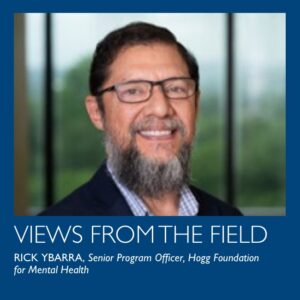Rick Ybarra, Senior Program Officer, Hogg Foundation for Mental Health
Philanthropy has forever espoused the term “sustainability.” We ask in grant applications and in our conversations with grant partners: “What’s your sustainability plan?” and “How do you plan to sustain your program once the grant ends?”
Thanks to the influence of Tom Klaus, formerly of Tenacious Change, my thinking has shifted and evolved over the past few years to “durability.” Tom founded Tenacious Change as an information hub for persons interested in learning more about community, organizational, and system change management. Tom, who is now mostly retired, has decades of experience with nonprofits, governmental agencies (local, state, federal), and in the private sector. He discovered that long-term success meant assessing and strengthening the key components of any organization, of any paradigm shift or movement, including funding. It was an eye-opener for someone who had always thought about sustainability as the end point.
“Durable” means to last a long time and comes to us from the Latin verb durare, meaning “to last.” Some of the synonyms for durable include:
- LASTING, which implies a capacity to continue indefinitely;
- PERMANENT, which adds usually the implication of being designed or planned to stand or continue indefinitely; and
- STABLE, which implies lastingness because of resistance to being overturned or displaced.
Once a grant ends, grant partners often lose their sustainability. And if their sustainability plan is to chase that next grant in hopes of backfilling the grant that ended … well, that’s not a sustainable sustainability plan.
So, what is the difference between sustainability and durability? Here is what I gleaned from Tom’s work on the difference between the two and why durability matters more—although sustainability is important, durability contributes more to long-term success. Achieving durability requires the following critical elements that make up what I think of as the durability “secret sauce”:
- Relationship building: Cultivating, strengthening, and sustaining relationships and building trust requires time. It often includes the need to work through and resolve differences and history to see a greater vision and purpose.
- Co-creation: Bringing people together to identify the conditions that contribute to poor physical and mental health, proposing solutions to address challenges, and co-creating a unifying purpose can lead to a shared community vision of good health.
- Ownership mindset: Developing an “ownership mindset” individually and collectively leads to unifying purpose. True ownership means people see themselves as accountable for what the group does (outcome), and how the group does it (activity . This ownership mindset results in stronger investment and commitment because individuals who participate in the process of co-creation see themselves as a stakeholder and as having a stake in the success of this collective effort.
- Cultivating future leadership: Includes preparing and transferring of the ownership mindset to the next generation of leaders. Investing in sharing experience, wisdom, and time (coaching and mentoring) to support and inspire future leaders. It means the willingness to hand off the torch, step aside, and support new leadership.
- Nimble and flexible enough to change forward: Being nimble or flexible enough to change forward to a better state—to withstand the ebbs and flows of changes (at times immediate and dramatic)—is critical for longevity. This applies to a program, service, coalition or collaborative, organization, workforce, governmental agency, academic institution, special interest group, movement, private business, and funding.
- Constant state of learning: Continuing to assess efforts and outcomes is essential to determine progress. For example, changes to staff or community members, market conditions, and funding can positively or negatively impact an organization or a collective effort. What is important is that there is a constant state of learning based on a feedback loop on what is working, what is not working and why, what—if any—strategy adjustments should be made, and the implementation of new course correction and the assessment of the outcome of the course correction.
When something reverts to a previous state, it is often referred to as a “snapback.” The snapback phenomenon is often the result of opposition, disruption, or fear—or a combination thereof. And a rubber band can only stretch and snap back so many times before it eventually breaks. We see that happen to organizations and movements—and to funding.
So therein lies one of the big differences between the two: sustainability is centered on the funders’ interest (continuing the program once the grant closes) whereas durability is centered on the best interest of the organization and community it serves.
Organizations, businesses, projects, and movements (political, programmatic, and funding) strive to maintain a homeostasis and to be relevant for as long as possible. That’s a good thing. Their ability to do so can be seen as building durability rather than sustainability. Tom emphasizes that durability depends on adaptability—which is the willingness and ability to change forward and successfully weather the storms many nonprofits face in today’s world.
You can probably see how the concept of durability applies to the nonprofit sector, governmental agencies, academia, and the private sector. Pretty much everywhere you look, including the field of philanthropy.
In other words, one must be adaptable to the environmental changes that you come face-to-face with. To survive and thrive, one must be durable. Political challenges, funding challenges, movement challenges—all must be durable to continue through the turmoil of implementing the work toward the desired goal.
These are the real current and future challenges our grant partners and the nonprofit sector face. They think about sustainability when they should be thinking about durability.
Lastly, to make the values shift to durability, philanthropy must internalize and practice humility. We have expertise but are not experts in the communities we invest in. It’s more complex than having the knowledge base—we must engage and honor the expertise, voice, and lived experience of communities who face these challenges every day. Rather than prescribing our own solutions to the communities we support, we should acknowledge our partners’ deep understanding of the issues and relationships with people on the ground by simply asking them what they think would make a difference in achieving a healthier community. Then trust communities to design, implement, and test community-defined, community-led, and community-driven solutions. Leaning into “context expertise” (community voice) versus content expertise.
I invite and challenge the field of philanthropy to make the values shift from sustainability to durability. That means using philanthropy’s expertise, leveraging relationships, and investing in compelling and persuasive messaging to help organizations cultivate new donors or solidify existing local donors. It means helping create additional strategies designed to cultivate funding streams outside of the traditional funder world. In rural communities, local businesses, ranch and property owners, and small and large business enterprises are potential sources of durable, local funding that have potential to create long-term or legacy funding. Ownership mindset versus “buy-in.”
We ask the organizations we fund to “put skin in the game.” If we truly believe in a grant program we are investing in, whether it be a one-year grant program, three-year grant program, or longer, we have a moral and ethical obligation to also put skin in the game to support building the durability of the organizations and programs we are investing in. To leverage our expertise, assets, resources, and vast, multisector networks to support organizations’ work to become durable. To support our grant partners not just to survive but to thrive. Not just to be sustainable but to be durable. That’s how philanthropy can contribute to supporting and building a stronger, more robust, and durable nonprofit sector.
Merriam-Webster. (n.d.). Durability. In Merriam-Webster.com dictionary. Retrieved September 18, 2024.
Klaus, T. Tenacious Change is now Klaus Haus Productions at www.klaushausllc.com. You can also email tom@klaushausllc.com.

